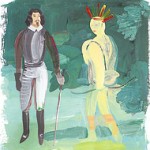By David Hackett Fischer
David Hackett Fischer likes to start his historical narratives — or, to put a fine point on them, learned entertainments, peerless and priceless — by reading a painting. Not always, but often enough: Copley’s portrait of an unbuttoned Paul Revere speaks volumes about the man at the launch of “Paul Revere’s Ride”; Leutze’s “Washington Crossing the Delaware” is translated from the Romantic to discover meaningful themes in “Washington’s Crossing” and the dramatic, world-changing event it chronicles.
The beginning of “Champlain’s Dream” finds a 17th century engraving under scrutiny. It pictures Samuel de Champlain, the French explorer (to name one of his many hats) and founder of Quebec, in a less-than-happy engagement with a group of Mohawk men. The engraving allows Fischer to get under Champlain’s skin and into his head, to tell us something about his station and command, his mettle and the abiding relations, for better or worse, he formed with the indigenous populations of what was to become New France, later Canada.
Balance, writes Fischer, has not been a hallmark of Champlain studies, and it is his intention to probe a middle way between hagiographers and iconoclasts. It proves to be an empathetic inquiry — as Champlain proves to be an engaging, empathy-worthy character — as well as honest and mature. When the material is mined from solid ground, well and good, but Fischer is scrupulous to admit when he is chasing shadows.
Without an opening thesis or agenda, Fischer comes at Champlain with freshness of purpose and a faith that historical knowledge will deliver something of value: Who was this man? What did he do, why did he do it, why should we care? “The answers to all these questions make a story,” he says. Yes, they do, and a good one.
Champlain grew up in the Atlantic seaside town of Brouage during the last decades of the 16th century. At the time, Brouage was a small, vibrant port and a borderland between cultures and religions. Champlain became comfortable with diversity at an early age and weary of the cruel religious wars that raged throughout France. He became a Catholic, but like his king Henri IV, he shared the large spirit of French Christian humanists who “were students of the world, with a passion for the pursuit of knowledge, as a way of understanding God’s purposes.”
That passion for knowledge extended to curiosity about the New World and how it might play a part in the creation of a greater France, an enlightened enterprise combining exploration, trade and settlement in an effort to increase France’s power and prosperity, and in the process bringing together many kinds of people.
The fortunes of the settlements Champlain launched on the banks of the St. Lawrence River, starting in 1603, would wax and wane, prey to the ferocious northern winters and the heavy weather of French politics. Fischer is equally at ease describing the effects of scurvy and cold on the small bands of settlers or unraveling the intrigues of Maria de Medici and Cardinal Richelieu.
On the other hand, Champlain’s relations with a wide number of native populations, excepting the Iroquois, were steady and positive. Fischer’s Champlain was a rare bird in the colonizing world, free of egoism and cupidity, seeking his Arcadian ends through the means of mutual interest and reciprocal trust with the Indians. His fascination in them wasn’t a ploy but a genuine expression of his humanism. He behaved respectfully, honored customs even when he did not admire them, cut the natives a relative slack he would never have accorded the European common man.
True, writes Fischer, the gentlemen of New France — Champlain among them — “were quicker to recognize the humanity of the Indians than that of their own servants and laborers.” Champlain would not flinch at burning an offending book, nor was he a champion of free speech or a classless society. And it would be absurd to expect as much. But bright sparks of decency, amity and concord animated his behavior, earmarks of a progressive who lived on the bridge between the Renaissance and the Enlightenment.
Fischer well heeds the stream of color and excitement, like a great blast from Champlain’s arquebus, that attended the colonial dream, wherein most of the skulduggery and fighting was with other Europeans: treacherous Frenchmen and marauding Englishmen, though the Iroquois stuck an arrow in Champlain’s neck for good measure. The power of Fischer’s writing is on the mind’s eye; it’s an immediate and sensual narrative of cinematic quality, and it’s aided by a wealth of antique maps, old portraits and a hearty collection of source-material appendixes.
It is a pleasure to watch the principled leadership of a man blossom and his projects endure. Champlain was interested in “learning to make sound judgments on the basis of imperfect knowledge.” That can also be said of Fischer’s artful approach to the telling of history.
(from The San Francisco Chronicle)
